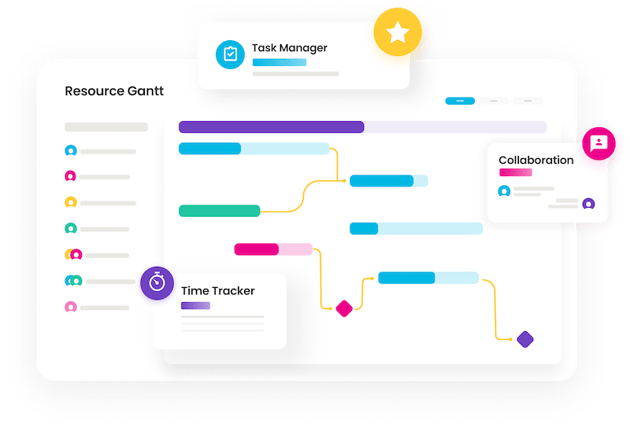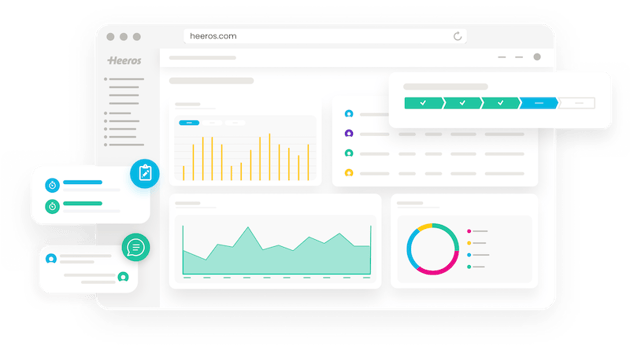Blog
How to Succeed in All 5 Phases of Project Management
Project life cycle phases can be broken down into five clear project phases. The 5 phases of project management include project initiation, project planning, project implementation, project monitoring, and project closure. All project phases along the project life cycle are equally important, and each phase requires a slightly different approach.
Maintaining a firm grasp over each step is essential for anyone hoping to succeed in project management. In this article we will review each project phase, and their to-do lists.
5 Phases of Project Management
- Project Initiation
- Project Planning
- Project Implementation
- Project Monitoring
- Project Closure
1. Project Initiation
The prospects and risks related to a project should always be carefully evaluated. This type of preparation ensures that only projects in which the benefits can outweigh the costs, or in other words when the Benefit-Cost Ratio (BCR) is sound, actually go into execution. You can use data from previously completed projects to assess these factors.
"A benefit-cost ratio (BCR) is a ratio used in a cost-benefit analysis to summarize the overall relationship between the relative costs and benefits of a proposed project."
The project manager and project team should also define a clear need for the project, as well as specific goals and realistic cost estimates. All project team members should understand what and why they are trying to achieve in each of the project management phases.
To-do in Project Initiation Phase:
- Assess the prospects and risks of the project
- Define the project - set specific goals
- Draft a preliminary schedule and budget for the project
- Assess the amount of work hours necessary to complete the project
- Request quotes from subcontractors
2. Project Planning
This phase should include definition of project scale and coverage, as well as clarifying the initial goals and objectives. Project scheduling, resourcing and budgeting are also very important, and they should all be documented in a project plan. It can be useful to break a project down to several smaller sections too. This will help assess the required resources and costs of each section separately.
A good project plan defines the deliverables, scope, budget, schedule, and goals of the project. These goals should be realistic, so that progress can be tracked and measured along the way. In addition to a final goal, project plans should include milestones, which help break down and clarify the progression of the project. Sample Gantt Chart
Sample Gantt Chart
Milestones are often entered into a Gantt chart. This tool visually represents the project timeline and makes tracking tasks, activities, and the progress of the project easier. Gantt chart tools are usually included in project management software.
With any project, but especially larger ones, risk management is also very important. You should identify risks, and prepare for them beforehand. The possible outcome of a project depends on a number of internal and external factors.
“A good plan today is better than a perfect plan tomorrow” Proverb
Even the most careful preparation and planning might not lead to success every time. This is why surprises, setbacks and failures should also be prepared for.
To-do in Project Planning Phase:
- Write a precise and comprehensive project plan
- Build a clear assessment for resources, budget and schedules
- Assess the profitability of the project
- Choose the indicators you will monitor
- Analyse and minimise risks
3. Project Implementation
When kicking off the project implementation phase, it is a good idea to go through all of the steps with the people involved and clarify the responsibilities of each and every one. In this project phase, the prepared plan is finally set in motion. Project deliverables are developed, and the main focus lies on assigning resources to tasks. Project teams should maintain clear communication and a strong sense of collaboration.
Responsibilities and goals should be clarified to all project team members. Everyone working on the project should be provided with sufficient information about the project all throughout the project life cycle.
The easiest way to maintain the flow of information is to collect all project-related information, including tasks, deadlines, memos, and attachments, onto one single platform such as professional service automation (PSA) software. The entire team should have access to this data, so the user-friendliness of the tool is very important. An easy-to-use project management tool, either as a standalone, or even better when part of a PSA software, can help with resourcing and getting an overview of the project at any given time. PSA Software to manage projects, tasks, activities, resources, & collaboration
PSA Software to manage projects, tasks, activities, resources, & collaboration
Maintaining control over the progress and resourcing of the project is imperative. You should also identify potential challenges as soon as possible, so necessary changes can be made.
A nimble and adaptable approach is the only way to ensure the project sails through challenges. Remember, it's not a failure to change schedules or adapt costs during a project. Adaptability is a strength and can lead to great success.
To-do in Project Implementation Phase:
- Follow the previously prepared plan as closely as possible
- Accept that plans can change at any time in the project life cycle; remain ready to adapt in all project phases
- Make sure that all members of the project team understand their roles and the project goals
4. Project Monitoring
Project monitoring is an essential part of project management. It takes place simultaneously with the previous phase. Monitoring will help assess if changes to the schedule or resourcing are necessary. Changes to the plan are almost inevitable, but change can lead to good things.
All changes should be handled with care, in order to avoid scope creep. This refers to continuous or uncontrolled growth of change in a project's scope. This can happen if the scope of a project is not defined, documented, or controlled enough.
Project managers should also ensure that the project is progressing toward the goals set in the planning phase. Monitoring and measuring the progress of a project is done through different Key Performance Indicators or KPIs as a metric.
A comprehensive project management system offers invaluable support in the entire process. All aspects of the project, schedule, and resources are easily updatable and editable in one place, ensuring the necessary adaptability to changes. This can help you ensure the project will stay on the right track and progress toward success.
To-do in Project Monitoring Phase:
- Record all actualized schedules, costs, and other data in project management
- Monitor the chosen indicators regularly, and make changes if needed
- Consider a comprehensive project management system
5. Project Closure
In the last phase, the project manager will create a final report for the project. This report should detail success and failure in all project phases, and showcase the lessons learned. The report can provide useful information for future projects.
This complicated analysis is much easier if all project-related information has been properly documented in one single system. Business Intelligence (BI) reports help significantly to predict and get a birds eye view on the KPIs, and health of the project. A comprehensive project management system can be a great help, by generating useful reports and invaluable insights.
To-do in Project Closure Phase:
- Forward the project to the customer, or for internal use
- Terminate any possible contractors hired for the project
- Prepare a final project report
- Collect all project documentation and deliverables and store them securely
- Document ideas for future use; the project may be over but the work goes on
Good project management during all project phases is the key to efficiency
Project management requires analytical thinking, managing immense amounts of data, and making difficult decisions under tight deadlines and budgetary restraints. Managing all 5 project management phases and their demands in one comprehensive project management solution can make this task much simpler.
With the right project management platform, you can accurately and efficiently delegate tasks, make quick and informed decisions, manage risks, and handle all other details related to project management.
We might be biased toward the Heeros PSA all-in-one business management platform platform, but we believe Heeros has done something that no other product in the market has done before. Heeros PSA provides all the following features in one unified platform: CRM and contact management, real-time visibility into project schedules, financials, trends, automated project messenger, activities & memos, time tracking, resource planning, expense management, project invoicing, unlimited attachments, and real-time follow-ups, to name just a few.
Get in touch with Heeros PSA
To learn more about PSA software and our full range of all-in-one solution for professional services, check out our Heeros PSA and start a free trial!
Start your free trial today!
Read more about Heeros PSA
Time to boost your business?
Let's start by going through your current situation and needs, and then proceed towards the most suitable solution for you. Book a meeting with our sales or reach out to us by filling the form.

.png)
.png)
.png)